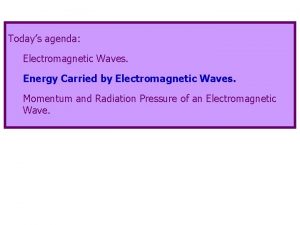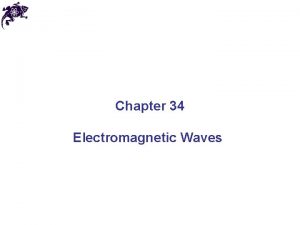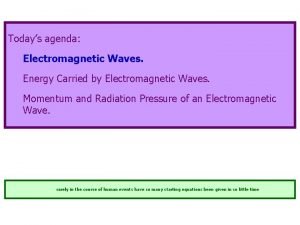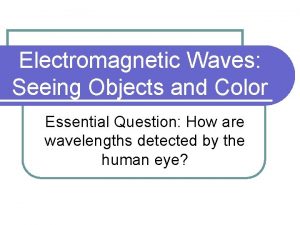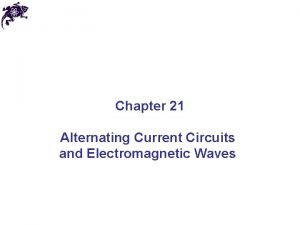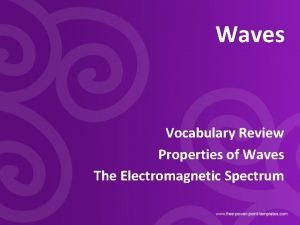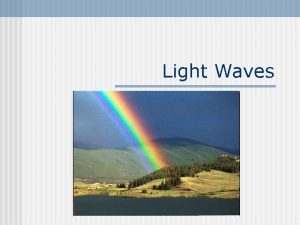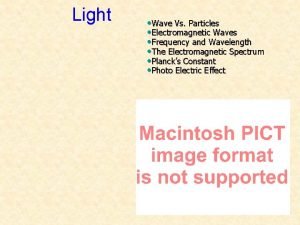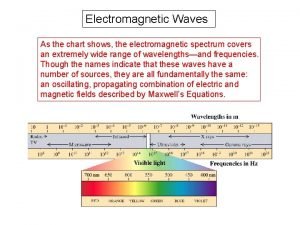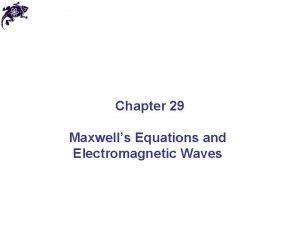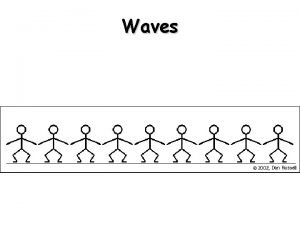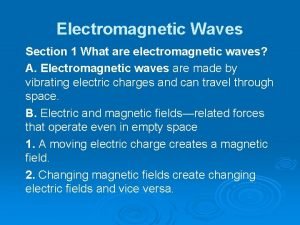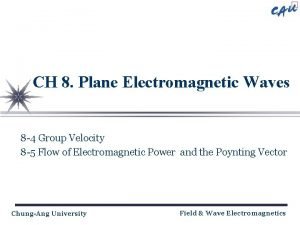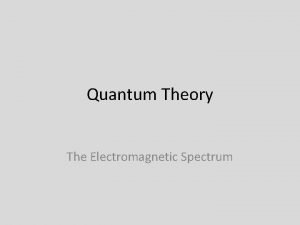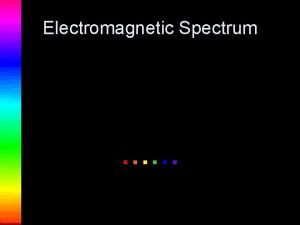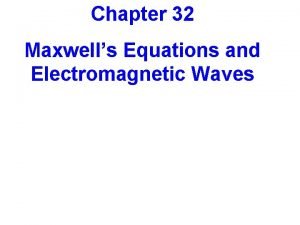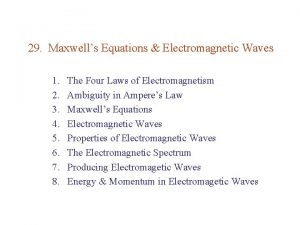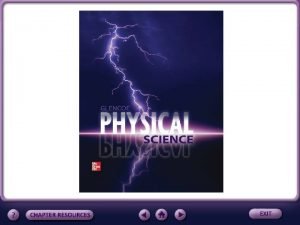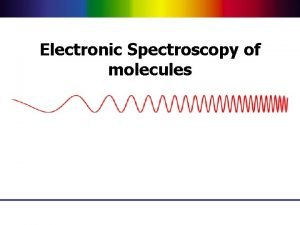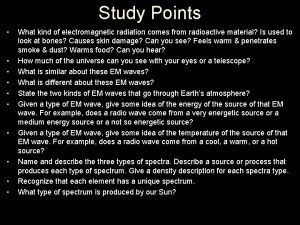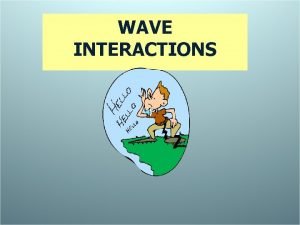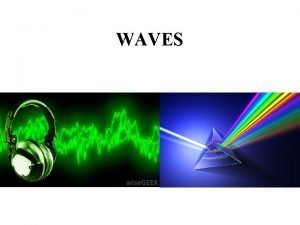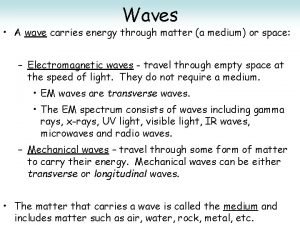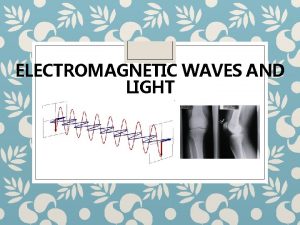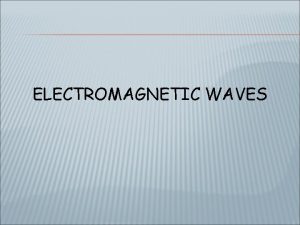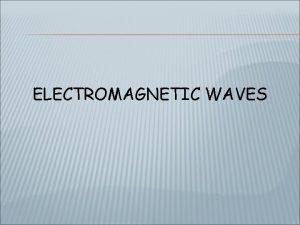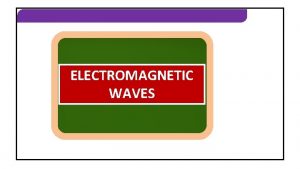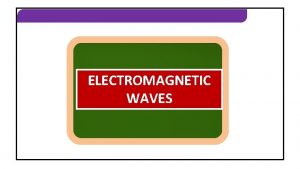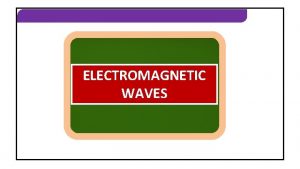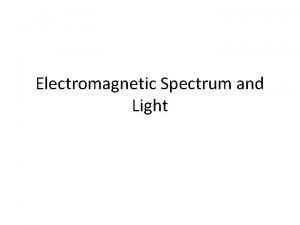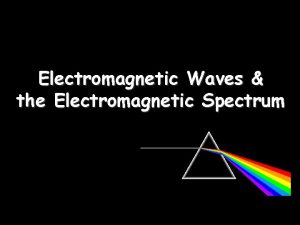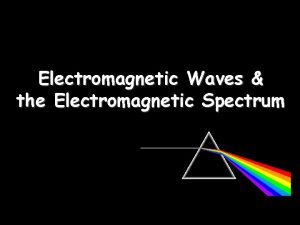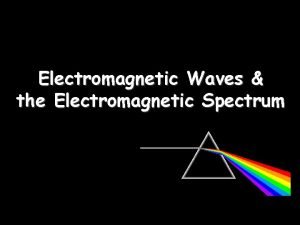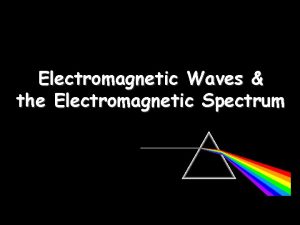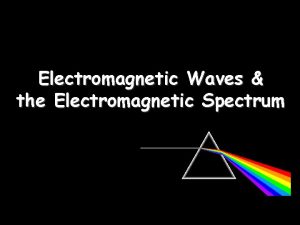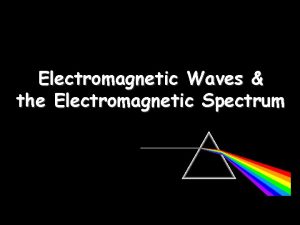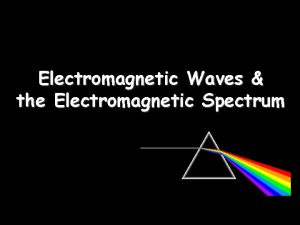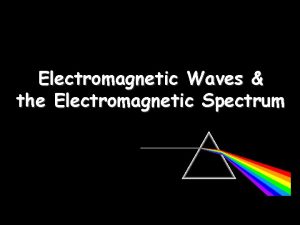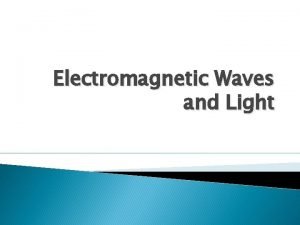Matter Energy Work Electromagnetic Waves Matter Energy and










































- Slides: 42

Matter, Energy, Work, Electromagnetic Waves

Matter, Energy and Work • Our universe is made of up matter and energy – Matter = “stuff” that has mass and takes up space – Work = the product of the magnitude of the force and the parallel distance through which the object moves – Energy = the ability to do work or cause change

Work • Process by which energy is transferred from one object to another • Involves both force and motion • Work = force x distance W = Fd • The unit of work is the joule (j) or N·m – Force (F) is measured in newtons (N) – Distance (d) is measured in meters (m) – 1 J = 1 N·m Copyright © Houghton Mifflin Company. All rights reserved.

Force • Force = push or pull • Forces are the cause of action, even when nothing is moving

Newton’s First Law of Motion An object at rest stays at rest and an object in motion stays in motion with the same speed and in the same direction unless acted upon by an unbalanced force. • Most of the time, those “unbalanced forces” are due to friction or gravity If you kick a soccer ball on frictionless ice, it will continue in a straight line forever

No work is done because there is no movement (d = 0) Copyright © Houghton Mifflin Company. All rights reserved.

Work IS being done because force (F) is being applied over a distance (d) Copyright © Houghton Mifflin Company. All rights reserved.

Your arms are NOT working because the direction of the force (F) is not the same direction as the distance

Work in the horizontal component NO WORK in the vertical component (d=0) When you move the lawn mower you are really exerting force in TWO directions Copyright © Houghton Mifflin Company. All rights reserved.

Newton’s Third Law of Motion For every action, there is an equal and opposite reaction • In other words, forces interact with each other • Most of the time those forces will be gravity and friction – When you are standing, gravity is exerting a downward force on you and your muscles are exerting an upward force – Because the forces are equal, but opposite, you are able to remain upright (no flying, no being pulled to the ground) Copyright © Houghton Mifflin Company. All rights reserved.

Energy and Joules • All types of energy are measured in tiny units called joules (J) … remember that work is also measured in joules • You may also hear these terms when discussing energy – Amps or amperes = measures electrical current – Volts = measures electrical energy – Calories = measures amount of energy need to change the temperature of one gram of water 1°C

Law of the Conservation of Energy cannot be created or destroyed Energy can change forms • The total energy of an isolated system remains constant • (total energy)time 1 = (total energy) time 2 Copyright © Houghton Mifflin Company. All rights reserved.

THERMAL Energy The ability to cause change. internal motion of particles NUCLEAR changes in the nucleus MECHANICAL ENERGY CHEMICAL bonding of atoms motion of objects ELECTRICAL Measured in joules (J) motion of electric charges


Kinetic Energy • The energy an object possesses because of its motion • Also called the energy of motion • kinetic energy = ½ x mass x (velocity)2 Ek = ½mv 2 (If an object is already moving) • Work = change (D) in kinetic energy • W = DEk = Ek 2 – Ek 1 = ½mv 22 - ½mv 12 Copyright © Houghton Mifflin Company. All rights reserved.

Kinetic Energy (KE) • Which has the most KE? 80 km/h truck • Which has the least KE? 50 km/h 80 km/h = kilometer per hour

Kinetic Energy Example • A 1. 0 kg ball is fired from a cannon. What is the change in the ball’s kinetic energy when it accelerates from 4. 0 m/s to 8. 0 m/s? • GIVEN: m = 1. 0 kg; v 1 = 4. 0 m/s; v 2 = 8. 0 m/s DEk = Ek 2 – Ek 1 = ½mv 22 - ½mv 12 DEk = ½(1. 0 kg)(8. 0 m/s)2 – ½(1. 0 kg)(4. 0 m/s)2 DEk = 32 J – 8. 0 J = Copyright © Houghton Mifflin Company. All rights reserved. 24 J

Potential Energy (PE) • The energy an object has because of its position or location • Also known as the energy of position • Most is due to gravity This boulder has greater PE • Other examples include – Springs (compressed or stretched) – Bowstrings Copyright © Houghton Mifflin Company. All rights reserved.

Gravitational Potential Energy • The gravitational potential energy (Ep) is equal to the work (W) done and this is equal to the weight (mg) times the height (h) W = Ep = mgh • m = mass of an object • g = standard gravity constant = 9. 8 m/s 2 Copyright © Houghton Mifflin Company. All rights reserved.

Gravitational Potential Energy Example • How much work is done lifting a 1. 0 kg book to the height of 1 m? • Work = W = (1. 0 kg) (9. 8 m/s 2) (1 m) = 9. 8 J • This is also the amount of Ep that the book has at a height of 1 m Copyright © Houghton Mifflin Company. All rights reserved.

Kinetic and Potential Energy: Law of Conservation of Energy • As potential energy increases, kinetic energy decreases • As the kinetic energy increases, the potential energy decreases • The total energy of the system never changes • WHY? Because energy changes from kinetic to potential and back (but is never lost/gained) PE KE Copyright © Houghton Mifflin Company. All rights reserved.

Forms of Energy • Thermal (heat) Energy – related to the kinetic and potential energies on a molecular level • Gravitational potential energy – from an object’s position, stored gravitational energy • Electrical energy – associated with the motion of electric charges • Chemical energy – molecular bonds • Radiant energy – sun • Nuclear energy – rearrangement of nuclei – Fission – breaking apart of larger nuclei – Fusion - smaller nuclei are put together Copyright © Houghton Mifflin Company. All rights reserved.

Heat Energy • All matter contains heat energy • The higher the temperature, the more heat energy there is – You put energy in to make something warmer – You take energy out to make something colder • Humans have created technology that transforms heat energy to other forms

Heat and Kinetic Energy • Energy of motion • Heat is actually kinetic energy • The “feeling of heat” is the energy moving between more -energetic atoms to the lessenergetic atoms

Waves • Waves carry energy (not matter) through a variety of mediums – Water waves (liquid) will bob you up and down but not sideways. – Earthquakes waves move through the earth. (solid) – Sound waves travel through the air. (gas) – Electromagnetic radiation waves travel through space. (void) Mediums = material through which a wave transfers energy Copyright © Houghton Mifflin Company. All rights reserved.

Longitudinal and Transverse Waves Two types of waves classified on their particle motion and wave direction: • Longitudinal – particle motion and the wave velocity are parallel to each other – Sound is a longitudinal wave. • Transverse – particle motion is perpendicular to the direction of the wave velocity – Light is an example of a transverse wave. Copyright © Houghton Mifflin Company. All rights reserved.

Longitudinal and Transverse Waves Longitudinal Wave Transverse Wave Copyright © Houghton Mifflin Company. All rights reserved.

Transverse Waves

Longitudinal Waves

Wave Description • Wavelength (λ) = distance of one complete wave (crest to crest or node to node) • Amplitude = maximum displacement of any part of the wave from its equilibrium position • Frequency (f) = number of oscillations or cycles that occur during a given time (1 sec) – The unit usually used to describe frequency is the hertz (Hz). – One Hz = one cycle per second – Shorter wavelength = higher frequency = higher energy • Period (T) = the time it takes for a wave to travel a distance of one wavelength Copyright © Houghton Mifflin Company. All rights reserved.

Frequency and Period • Copyright © Houghton Mifflin Company. All rights reserved.

T= ¼ s T= 1/8 s Copyright © Houghton Mifflin Company. All rights reserved.

Electromagnetic Waves • Consist of vibrating electric and magnetic fields that oscillate perpendicular to each other and the direction of wave propagation • ALL electromagnetic waves travel at the speed of light c = 3. 00 x 108 m/s = 1. 86 x 105 mi/s Copyright © Houghton Mifflin Company. All rights reserved.

Electromagnetic (EM) Spectrum The human eye is only sensitive to a very narrow portion of the electromagnetic spectrum (lying between the infrared and ultraviolet. ) We call this “light. ” Copyright © Houghton Mifflin Company. All rights reserved. Section 6. 3

Electromagnetic (EM) Spectrum • The entire range of EM waves in order of increasing frequency and decreasing wavelength – As you move from left to right, the wavelengths get smaller and the frequencies get higher – This is an inverse relationship between wavelength and frequency – WHY? All EM waves travel at the speed of light Speed or velocity = wavelength x frequency

Radio Waves • Have the longest wavelengths and the lowest frequencies; wavelengths range from 1000’s of meters to. 001 meters • Used in: RADAR, cooking food, satellite transmissions

Infrared Waves (heat) Have a shorter wavelength, from. 001 m to 700 nm, and therefore, a higher frequency. • Used for finding people in the dark and in TV remote control devices •

Visible Light • Wavelengths range from 700 nm (red light) to 30 nm (violet light) with frequencies higher than infrared waves. • These are the waves in the EM spectrum that humans can see. • Visible light waves are a very small part of the EM spectrum!

Visible Light Remembering the Order • ROY G. BIV • red • orange • yellow • green • blue • indigo • violet

Ultraviolet Light • Wavelengths range from 400 nm to 10 nm; the frequency (and therefore the energy) is high enough with UV rays to penetrate living cells and cause them damage. • Although we cannot see UV light, bees, bats, butterflies, some small rodents and birds can. • UV on our skin produces vitamin D in our bodies. Too much UV can lead to sunburn and skin cancer. UV rays are easily blocked by clothing. • Used for sterilization because they kill bacteria.

X-rays • Wavelengths from 10 nm to. 001 nm. These rays have enough energy to penetrate deep into tissues and cause damage to cells; are stopped by dense materials, such as bone. • Used to look at solid structures, such as bones and bridges (for cracks), and for treatment of cancer.

Gamma Rays • Carry the most energy and have the shortest wavelengths, less than one trillionth of a meter (10 -12). • Gamma rays have enough energy to go through most materials easily; you would need a 3 -4 ft thick concrete wall to stop them! • Gamma rays are released by nuclear reactions in nuclear power plants, by nuclear bombs, and by naturally occurring elements on Earth. • Sometimes used in the treatment of cancers.
 Difference between matter waves and electromagnetic waves
Difference between matter waves and electromagnetic waves Do electromagnetic waves require a medium
Do electromagnetic waves require a medium Examples of mechanical waves
Examples of mechanical waves Similarities of mechanical and electromagnetic waves
Similarities of mechanical and electromagnetic waves Mechanical and electromagnetic waves similarities
Mechanical and electromagnetic waves similarities What do all waves transmit
What do all waves transmit Sound waves are electromagnetic waves true or false
Sound waves are electromagnetic waves true or false Mechanical vs electromagnetic
Mechanical vs electromagnetic Energy density of electric field
Energy density of electric field Energy density of electromagnetic waves
Energy density of electromagnetic waves Energy carried by electromagnetic waves
Energy carried by electromagnetic waves Electromagnetic waves seeing objects and color
Electromagnetic waves seeing objects and color Alternating current circuits and electromagnetic waves
Alternating current circuits and electromagnetic waves Properties of waves
Properties of waves Compare and contrast p waves and s waves using venn diagram
Compare and contrast p waves and s waves using venn diagram A health inspector is measuring the intensity of a sound
A health inspector is measuring the intensity of a sound Electromagnetic waves characteristics
Electromagnetic waves characteristics Electromagnetic waves frequency
Electromagnetic waves frequency Electromagnetic waves chart
Electromagnetic waves chart Radiation powerpoint template free
Radiation powerpoint template free теория максвелла
теория максвелла Electromagnetic energy def
Electromagnetic energy def Emona durmati lyrics
Emona durmati lyrics Section 1 what are electromagnetic waves
Section 1 what are electromagnetic waves Power of electromagnetic waves
Power of electromagnetic waves Wavelength formulas
Wavelength formulas Electron spectrum
Electron spectrum Electromagnetic waves in water
Electromagnetic waves in water Electromagnetic wave equation
Electromagnetic wave equation Direction of electromagnetic waves
Direction of electromagnetic waves Concept of electromagnetic waves
Concept of electromagnetic waves Elextromagnetic spectrum
Elextromagnetic spectrum Section 1 what are electromagnetic waves
Section 1 what are electromagnetic waves Electromagnetic spectrum table
Electromagnetic spectrum table What type of electromagnetic waves cause sunburns? *
What type of electromagnetic waves cause sunburns? * Waves transfer energy without transferring
Waves transfer energy without transferring Waves are repeating disturbances that transfer
Waves are repeating disturbances that transfer Mechanical wave energy
Mechanical wave energy What is a semiconductor used for
What is a semiconductor used for Seismic waves
Seismic waves What are constructive waves
What are constructive waves Chapter 4 work and energy section 1 work and machines
Chapter 4 work and energy section 1 work and machines Characteristics of a longitudinal wave
Characteristics of a longitudinal wave








